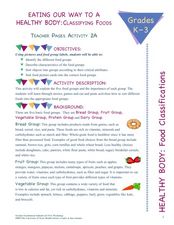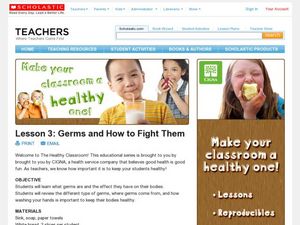Curated OER
Kinds of Maps
In this map worksheet, students match a set of descriptions with the names of different types of maps and answer true/false questions and short answer questions about using maps.
Curated OER
Proper Noun Gallery Walk Activity
Students are divided into groups. Each group is given a different colored marker or crayon and a piece of chart paper. Students are given 5 minutes to write on the chart all the proper nouns they can come up with. At the end 5 minutes...
Curated OER
Making Change
Learners identify different sources of pollution. In this environment lesson students view a video then make a commercial for the town.
Curated OER
About the U.S.A.
Students research the United States and discover its different climate zones, geographical features, animal life, and various cultures. Students complete a research chart using books, encyclopedias and the internet and present their...
Curated OER
History of Hong Kong
Eighth graders explore the sites and attractions of Hong Kong. For this Geography lesson, 8th graders research the different forms of transportation and major landmarks. Students create a travel brochure for Hong Kong.
Curated OER
File Card Bridges
Students make different variations of file card bridges and predict how much weight it will hold. In this file card bridges lesson plan, students put file cards between books in different ways and predict how many pennies it will hold.
Curated OER
Exploring Landforms
Second graders discuss the different types of landforms throughout the world. They pick one and research and present it to the class.
Curated OER
Oily Oceans
Students are read a book about oceans. They participate in an experiment discovering the effects of oil on water. They discuss different types of pollution and how they can be prevented.
Curated OER
Regions of North America: The Chesapeake Bay
In this reading comprehension learning exercise, students read an article on "The Chesapeake Bay". Students read 5 sentences and fill in each blank in each sentence with a word from the article. Students answer 3 short answer...
Curated OER
Watersheds and Wetlands
Students discuss the idea of a watershed. They build models of watersheds using paper and observe what happens to their models when it "rains". In addition, they build a second watershed to compare watersheds with wetlands to those without.
Curated OER
Eating Our Way to a Healthy Body: Classifying Foods
Students examine the major food groups. In this classifying foods lesson plan, students discover the 5 food groups as they read books and play games. Students then sort foods into the appropriate food groups
Curated OER
Making Sense of Things: The Human Body and Senses
Students conduct an experiment to evaluate the accuracy of their senses.
Curated OER
"Fish: Anatomy and Diversity in the Chesapeake Bay"
Students explore a variety of basic fish body form and their functions. They differentiate between different species of fish found in the Chesapeake Bay and St. Mary's River. In addition, they match pictures with descriptions using...
Curated OER
Air Masses
Students are given maps depicting two or more air masses and they then categorize bodies of air by temperature and moisture characteristics. They recognize large regions of similar type air. Students are given a map of air temperatures...
Curated OER
Outdoor Survival
Students are introduced to basic outdoor survival concepts. They identify the seven basic needs for survival. Students describe the symptoms and treatment for frostbite and hypothermia. They compare and contrast the value of different...
Curated OER
Shells
Sixth graders label diagrams of the 6 different classes of mollusks and explain the meaning of the labeled terms. They identify 8 common New Haven shells. They organize their own shell collection during this series of lessons.
Curated OER
Sponges
In this sponges worksheet, students will explore the characteristics of sponges including their different types of cells and body structures. Students will also determine how sponges reproduce. This worksheet has 3 short answer and 11...
Curated OER
Ecosystem Damage from Household Cleaners
Third graders assess the damage done to various ecosystems by cleaning products and discover how scientists test water quality. Using stream water and common household cleaning agents, they work in groups to test for pH levels. Once...
Curated OER
Inside-out Adaptations
Students describe sea stars adaptations and explain how these enable them to survive in different environments. For this animal adaptation lesson students watch a video, get into groups and create a list of characteristics of sea...
Curated OER
Bug Hunt
Students examine the different characteristics of bugs in their local area. They take characteristics of bugs they have observed and create their own new insect. They draw their new bug and share it with the class.
Curated OER
Methods of Heat Transfer
Eighth graders discuss the forms of heat transfer that relate to the human body. Discussion revolves around the ability of different designs of hats to change the rate of heat transfer to and from the body. Students then experiment...
Curated OER
The Life Cycle of the Butterfly
Second graders study the life cycle of a butterfly by observing metamorphosis taking place in a butterfly pavilion. Students illustrate their understandings of the body parts of a caterpillar and butterfly, as well as the life cycle,...
Curated OER
The Excretory System
In this excretory system worksheet, students read a brief excerpt about water balance and the excretory system. Then they identify what compound birds, insects and reptiles living in dry habitats excrete. Students also describe how...
Curated OER
Germs and How to Fight Them
Students learn how important it is to stay healthy. In this germ lesson plan, student learn what germs are and the effect they have on healthy bodies and explore how important it is to keep their bodies healthy through a classroom...























